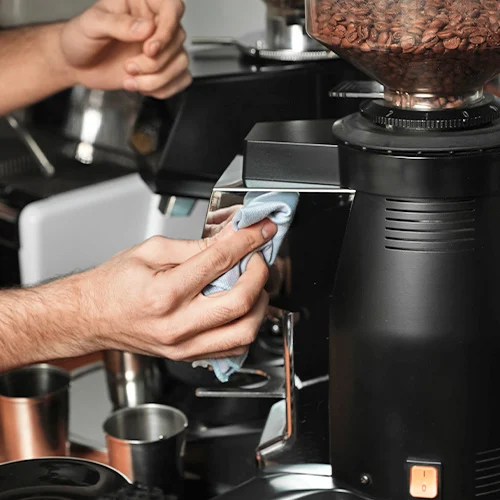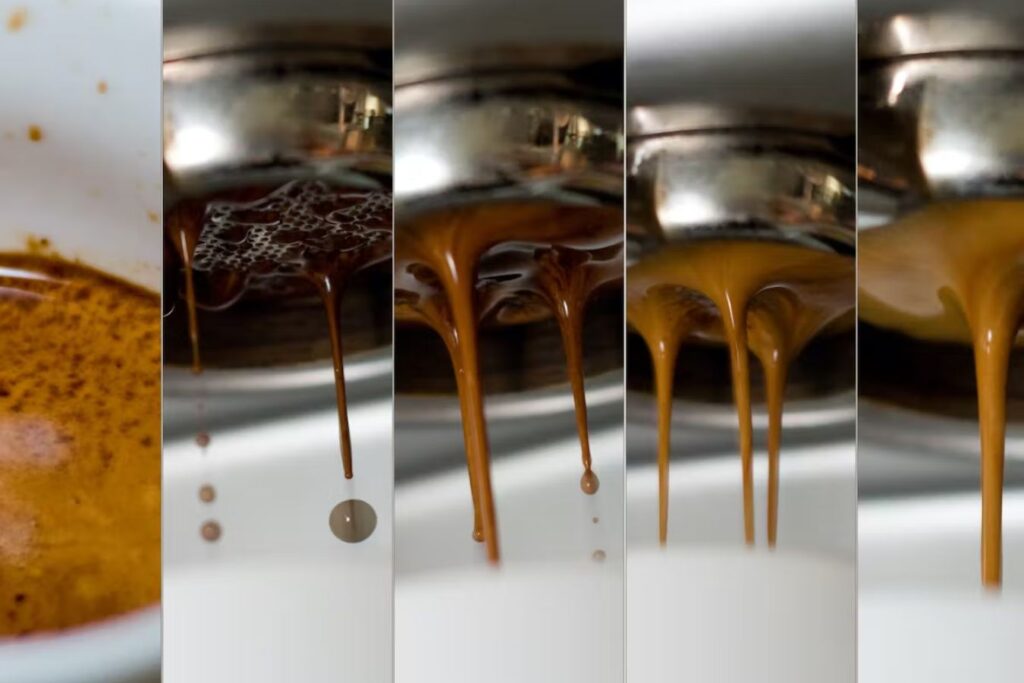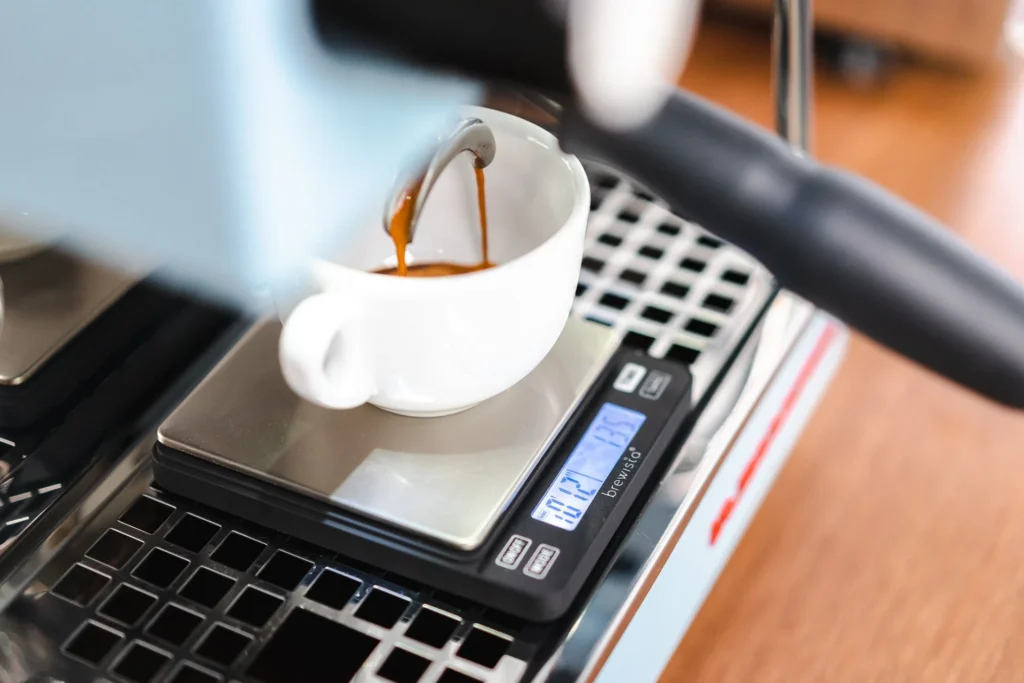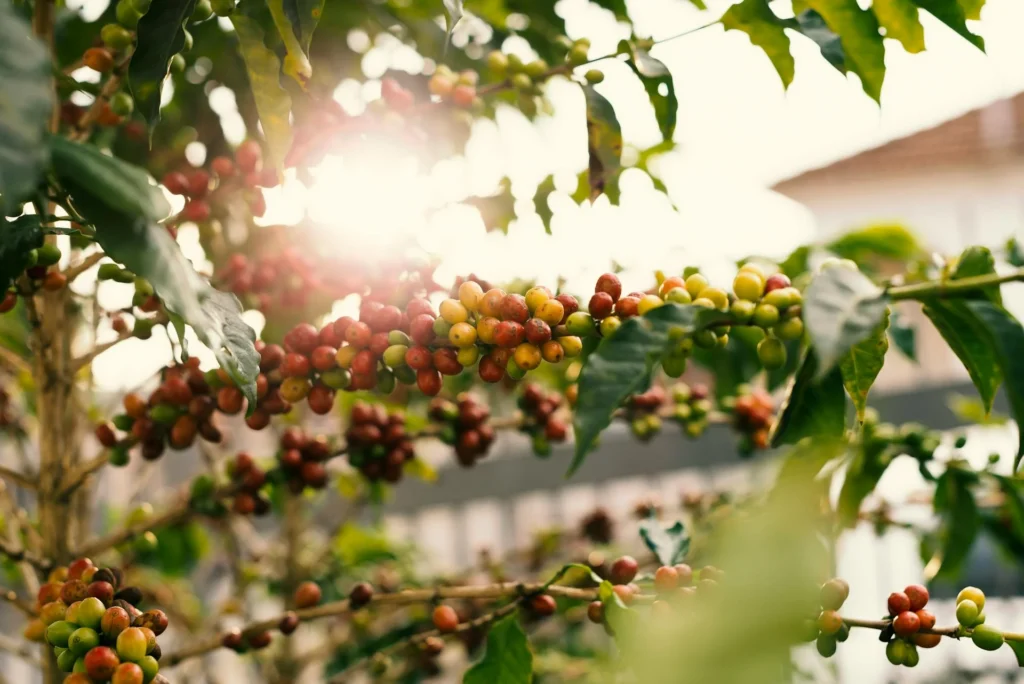Dialling in espresso means tweaking grind size, dose, and brew time to get the best flavor. This process is crucial for making great coffee at home. In this article, you’ll learn essential tips and techniques to perfect your espresso shots.

Key Takeaways
Dialing in espresso requires adjusting parameters like dose, grind size, and brew time to achieve perfect flavor extraction tailored to your coffee beans.
Consistency is key: precise measurements and gradual adjustments can significantly enhance your espresso’s taste, ensuring a balanced flavor profile.
Invest in quality tools, such as a burr grinder and a well-maintained espresso machine, to elevate your home brewing experience and achieve consistent results.
Understanding Dialling In

Dialing in brewed espresso involves adjusting brewing parameters to achieve the best flavor extraction. This ensures each shot is delicious and consistent in taste. Unlike a one-size-fits-all solution, this process considers the unique characteristics of different coffee beans.
Each coffee bean has its own story — origin, roast, and age all significantly influence how it should be brewed. Trusting your palate will guide the adjustments needed to achieve the perfect espresso blend.
Mastering dialing in requires patience and consistency, but the reward is a cup of coffee perfectly tailored to your taste.
Essential Parameters for Dialing In

Effective dialing in requires understanding and controlling several key variables: dose, grind size, and brew time. These interdependent parameters each play a crucial role in the final flavor of your espresso. Adjusting one often requires tweaking the others to maintain balance.
Humidity and temperature can also influence adjustments, making the process dynamic. Knowing the starting points and how to adjust from there sets you on the path to your perfect brew.
Dose Weight

The dose weight is the amount of ground coffee you use for each shot of espresso. Typically, the recommended dose weight for ground coffee in espresso ranges from 18-21 grams. For a double basket, this usually means 16-18 grams, but depending on the type of espresso, the range can be slightly broader.
Adjusting dose weight in small increments of about 0.2 grams can fine-tune extraction results. Accurate measurement is crucial, so aim for precision within +/- 0.2 grams. Evenly packed grounds help avoid channeling and achieve optimal extraction.
Grind Size

Grind size directly influences the extraction process; finer grinds slow it down, often leading to over-extraction, while coarser grinds speed it up, potentially causing under-extraction. If you want to achieve a better extraction, you may need to grind finer.
A burr grinder is essential for a uniform grind size, crucial for consistent extraction. Burr grinders work by crushing beans between a stationary and a rotating burr, ensuring even particle sizes and better flavor extraction.
Brew Time
Brew time, or extraction time, is the duration water contacts the coffee grounds. Ideally, brew time for espresso falls between 22-40 seconds, with 25 to 30 seconds often being the sweet spot for balanced flavor.
Adjust brew time by modifying grind size, dose, or tamping pressure. Careful monitoring and tasting help avoid over-adjusting, which can lead to undesirable flavors.

Creating Your Brew Recipe

Creating a brew recipe involves balancing dose, grind size, and brew time. Start by choosing the dose, typically between 18-21 grams. Next, determine the brew ratio — the relationship between the amount of coffee used and the volume of the drink produced, with a common starting point being a 1:2 ratio.
Extraction time should ideally range from 25 to 30 seconds. Understanding and adjusting these variables allows you to create a recipe that consistently delivers delicious and balanced espresso.
Step-by-Step Guide for Dialing In Espresso

Dialing in espresso is a systematic approach to achieving the perfect shot. Each component — dose, yield, and time — directly impacts flavor and consistency. By following a structured method, you can replicate great shots and refine your technique over time.
Measuring Dose
Start with a consistent dose, adjust the grind size to control extraction, and monitor brew time closely. This process enhances the brewing experience and ensures a consistently enjoyable cup of espresso.
Precise measurements are crucial for consistency. Use a scale to measure the dose accurately, aiming for within +/- 0.2 grams to ensure each shot is prepared with the same amount of coffee.

Adjusting Grind Size

If your first shot extracts too quickly, say in 21 seconds, adjust the grind to be finer. Make these adjustments in small increments to avoid drastic changes in flavor.
A finer grind slows extraction, allowing more flavors to develop, while a coarser grind speeds it up, potentially leading to under-extraction. Fine-tuning the grind size is key to achieving the desired espresso taste.
Monitoring Brew Time
Brew time directly influences espresso quality. Under-extraction results in a sour taste, while over-extraction leads to bitterness. Adjusting grind size, dose, or tamping pressure can help fine-tune brew time.
Careful monitoring and tasting during the brewing process can inform whether to shorten or extend the brew time to achieve better results.
Tasting and Fine-Tuning
Continuous tasting refines your espresso-making process. The aroma, body, and finish significantly influence flavor perception. Regular tasting helps identify areas for improvement and necessary adjustments. It helps evaluate the balance of acidic, sweet, and bitter flavors, guiding you in fine-tuning your brew.
Tasting the Espresso Shot

Tasting espresso shots is critical for evaluating balance and identifying unpleasant flavors. Signs of under-extraction include a thin mouthfeel and a lack of sweetness. A taste sour might indicate low brewing temperature, while a burnt and bitter taste suggests the temperature is too high.
Ideal extraction times typically range from 25-30 seconds, providing a balanced flavor profile.
Making Small Adjustments
Small tweaks in brewing parameters can significantly enhance the espresso experience. Accurately measuring dose weight, typically between 16-21 grams, affects the strength and flavor profile.
If your espresso tastes sour, adjust the grind to a finer setting. Conversely, if it’s bitter, try a coarser grind. Brew time adjustments, aiming for 22-40 seconds, can also help achieve the perfect extraction.
Tips for Successful Dialing In

Using fresher coffee beans can help prevent over-extraction due to reduced surface exposure. Filtered or mineral water enhances espresso extraction quality. Regular cleaning of your machine prevents the buildup of coffee oils, which can affect flavor.
Keeping a journal of your dialing in parameters helps refine your technique over time. Modify one variable at a time during experimentation for better tracking of changes.
Common Issues and Solutions
Even experienced baristas encounter issues like over-extraction and under-extraction. Over-extracted espresso often tastes bitter and harsh, lacking sweetness and complexity. Under-extracted espresso generally has sour, sharp, or watery flavors, lacking a full-bodied taste.
To address these issues, adjust your grind size, dose weight, or brew time. Understanding these adjustments helps achieve a balanced and flavorful espresso.
Over Extraction

Over-extraction occurs when too much of the coffee’s soluble materials are dissolved during brewing, leading to undesirable flavors. Signs include a bitter taste, ashier flavors, a dark oily crema, and an astringent mouthfeel.
To correct over-extraction, adjust your grind to be coarser or reduce brew time. Monitoring extraction levels is crucial for achieving balanced flavors.
Under Extraction

Under-extraction often results in sour-tasting espresso with a viscous consistency. This occurs when water passes through the coffee grounds too quickly, not extracting enough flavors.
To improve under-extracted espresso, grind your coffee finer or increase the dose weight. These adjustments increase extraction time and help achieve a fuller-bodied and balanced shot.
Tools and Equipment for Home Baristas

Achieving high-quality espresso at home requires the right tools and equipment. A well-equipped setup enhances your brewing experience and ensures consistency and precision in every shot. Essential tools include a reliable espresso machine, a quality burr grinder, and regular maintenance.
Regular cleaning of your espresso machine and other equipment avoids the buildup of coffee oils and residues that can alter flavor. Proper maintenance ensures your equipment performs optimally and delivers the best results.
Burr Grinder
A burr grinder is indispensable for any home barista. Burr grinders provide a consistent grind size, crucial for optimal espresso extraction. They crush coffee beans between a stationary and a rotating burr, ensuring uniform particle sizes and better flavor extraction.
Purging the grinder regularly clears out stale coffee from the burrs, ensuring fresher grounds for each shot. Using a burr grinder results in more balanced and flavorful espresso, making it a worthy investment for serious coffee enthusiasts.

Espresso Machine Maintenance

Routine maintenance of your espresso machine ensures consistent coffee quality and extends the machine’s lifespan. Tasks such as descaling to remove mineral buildup, changing water filters regularly, and cleaning shower screens and portafilter baskets prevent leaks and ensure optimal performance.
Annual professional servicing can catch issues not visible during regular maintenance, helping to avoid costly repairs and keep your machine in top condition. Proper maintenance enhances your brewing experience and guarantees consistently delicious coffee.
Summary
Mastering the art of dialing in espresso involves understanding and adjusting various brewing parameters such as dose, grind size, and brew time. By carefully calibrating these elements, you can create a brew recipe that consistently delivers a delicious and balanced espresso.
The journey to the perfect espresso is one of patience and experimentation. Using the right tools, maintaining your equipment, and continuously tasting and fine-tuning your process will help you achieve barista-level espresso at home. Embrace the process and enjoy the rich rewards of a perfectly brewed espresso.
Frequently Asked Questions
What does dialing in espresso mean?
Dialing in espresso is all about fine-tuning variables like dose, grind size, and brew time to unlock the perfect flavor in your cup. Get ready to experiment and elevate your espresso game!
How does grind size affect espresso?
Grind size plays a crucial role in achieving the perfect espresso, as a finer grind slows down extraction and can lead to over-extraction, while a coarser grind speeds it up, risking under-extraction. Adjusting your grind size can help you craft the rich, balanced flavor you desire!
What is the ideal brew time for espresso?
The ideal brew time for espresso is 25 to 30 seconds, ensuring a perfect balance of flavor and intensity. Aim for this time to elevate your coffee experience!
How can I correct over-extracted espresso?
To correct over-extracted espresso, adjust your grind size to be coarser or shorten the brew time. You’ll taste the difference and elevate your coffee game!
Why is regular maintenance of espresso ground coffeemachines important?
Regular maintenance of espresso machines is essential for preserving consistent flavor and extending their lifespan by preventing buildup of coffee oils and residues. Embrace this practice to enjoy the perfect cup every time!
Why Does Espresso Sometimes Taste Sour or Bitter?
Espresso can taste sour when under-extracted, often due to a grind that’s too coarse, short shot time, or low water temperature. Over-extraction, caused by too fine a grind or excessive shot time, can produce bitterness and unpleasant flavours. Adjusting variables like grind size, tamping, and shot time helps balance the flavor.
What Role Does the Filter Basket Play in Espresso Extraction?
The filter basket holds the ground coffee during brewing and ensures even water distribution. A clogged or uneven basket may cause water to take the path of least resistance, leading to uneven extraction. Proper maintenance and choosing the right basket size for a double shot or single shot are crucial for consistent results.
What Should You Look for in the Coffee Puck After Brewing?
The coffee puck provides clues about your espresso extraction. A firm, dry puck indicates even water distribution, while a wet or uneven puck suggests issues with tamping, grind size, or the dispersion screen. Consistency in the puck is key to better espresso results.
How Does Roast Type Affect Dialling In?
Darker roasts extract more quickly, often requiring a coarser grind to avoid over-extraction. Lighter roasts, with their bright acidity and complex flavors, benefit from a finer grind and longer shot time to fully extract their delicate notes. Tailor your grind and brewing process to the roast for the best results.
What is Target Yield in Espresso?
What Should I Adjust for My First Shot?
What is Target Yield in Espresso?
The target yield is the amount of espresso extracted from the dry grounds. For instance, using 18g of coffee to produce 36g of espresso follows a 1:2 brew ratio. Achieving the desired yield ensures a balanced flavor in the final beverage.
What Should I Adjust for My First Shot?
For your first shot, start with a standard 1:2 brew ratio (e.g., 18g of coffee to 36g of espresso). Check shot time and flavor. If the shot runs too quickly, grind finer. If it’s slow or overly bitter, grind coarser. Dialling in requires incremental changes to optimize flavor.
How Does Water Temperature Affect Espresso?How Does Water Temperature Affect Espresso?
Optimal water temperature for espresso is 195–205°F (90–96°C). Lower temperatures can cause the espresso to taste sour due to under-extraction, while higher temperatures can result in bitter flavors. Adjust the temperature to suit different roast profiles, such as lighter roasts.
Why is Tamping Important in Espresso Making?
Tamping compresses the ground coffee into a firm, even tamped coffee bed, ensuring uniform water flow during extraction. Uneven tamping can lead to under-extraction or over-extraction, causing the espresso to lack balance and flavor.
What Does Shot Time Mean in Dialling In?
Shot time is the duration it takes to pull an espresso shot, typically 25–30 seconds for a double shot. Shot time is influenced by grind size, tamping, and the brew ratio. Adjust these variables to achieve a balanced extraction and consistent flavor.
Can I Use New Coffee When Dialling In?
Yes, but fresh beans often require adjustments. When using new coffee, experiment with grind size, dose, and brew ratio to achieve your desired yield. Each coffee has unique characteristics that may require tweaking your approach.
How Does Fine Table Salt Relate to Grind Size?
An espresso grind should resemble fine table salt in texture. If the grind is too coarse, the shot may under-extract and taste weak. If too fine, it can clog the basket and result in over-extraction. Proper grind size is essential for optimal flavor and flow.
What’s the Final Beverage in Espresso Making?
The final beverage is the extracted espresso shot, complete with crema and balanced flavor. Achieving your target yield ensures the final beverage matches your desired taste profile, whether bold or nuanced.





